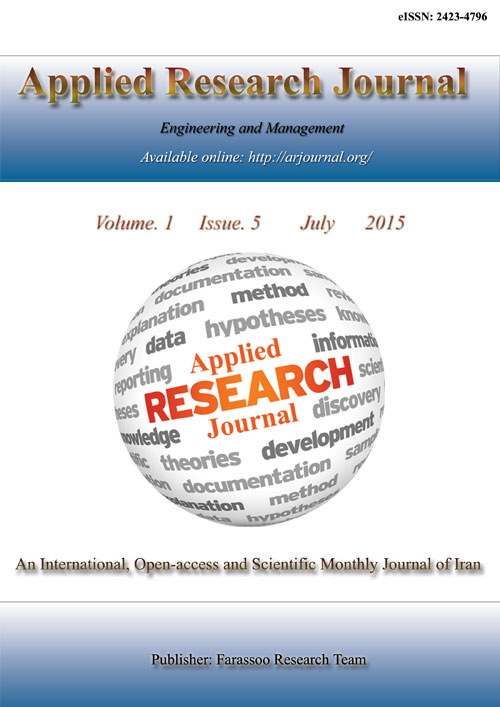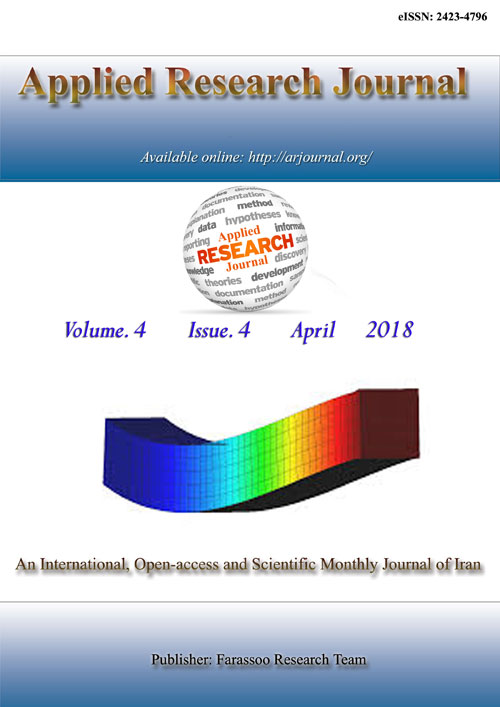فهرست مطالب

Applied Research Journal
Volume:1 Issue: 5, jul 2015
- تاریخ انتشار: 1394/06/26
- تعداد عناوین: 10
-
Pages 301-306Agricultural practices contribute largely to emissions of the greenhouse gases especially CO2, CH4 and N2O, which potentially affect climate change mainly through trapping of long wave radiation emitted from the earth. Volatilization of nitrogen in denitrification and chemical reactions involving nitrates under aerobic conditions in nitrogenous mineral fertilizers applied to the soil results in the emission of nitrous oxide gas. During the decomposition and mineralization of organic matter applied to the soil, CO2, CH4 and N2O gases are emitted into the atmosphere. The emission factor for N2O gas species was estimated as N2O: 2.11 g kg-1. Rates of emissions of N2O increased similarly to increasing amounts of poultry manure as well as cattle manure. The poultry manure treatments released higher amount of gases in all cases than the cattle manure treatments. The emissions of N2O estimated for the poultry manure were higher compared with that of cattle manure treatments under the study.Keywords: Cattle Manure, Fertilizer, Greenhouse Gases, Nitrous Oxide, Poultry Manure.
-
Pages 307-310Due to the water shortage problem in Iran, water supply is currently of great importance. In such a circumstance, according to the gradual and strict evolution of environmental standards and the need for re-use of wastewater, especially for agriculture and irrigation, improvement of the quality of the wastewater treatment plant swage is necessary. The presence of this wastewater next to the urban centers may increase agricultural products, around these regions. According to this study, the performance of the wastewater treatment plant in Ilam was examined and evaluated for 4 consecutive months (from April 2014 to July 2014) by analyzing the quality indices, TSS, COD, BOD5, heavy metals (cadmium, copper, lead) and the total and fecal coliforms. The average parameters are 49, 95.15, 50, 0.022, 0.015, 0.50 mg/l, 5 and 5, respectively that in the event of reuse for agricultural purposes, the drop in the quality of parameters mentioned above should be considered at environmental standards level. The results indicated that the above swage has no restrictions for use in agriculture, except for total and fecal coliforms.Keywords: Environmental Standards, Wastewater Reuse, Agriculture, Urban Wastewater Treatment, Quality Index
-
Pages 311-315Biosorption is considered a potential alternative for the removal of heavy metals from waste solutions to other conventional processes. The existence of copper in industrial waste water is normally in the structure of bivalent Cu(II) as a hydrolysis product or as CuCO3 in the form of organic complexes and its concentration may reach up to 0.1-0.12g.l-1, which according to the world health organisation water quality standard has to be reduced to 0.0010-0.0015g.l-1 to render it non-toxic in the industrial waste water. This study clearly indicates the effect of contact time, particle size, pH, metal concentration as well as biosorbent concentrations on Cu(II) ions removal from industrial effluents.Keywords: Biosorption, Copper (II) ions, Heavy metals, Waste Water
-
Pages 316-319The antidiabetic (hypoglycemic) activity of Tinospora cordifolia (Menispermaceae) investigated in alloxan treated albino rats. The rats weighing 150-190gm were administered intraperitonealy with 180mg/kg body weight dose of alloxan monohydrate for the induction of diabetes. The oral dose of alcoholic extract of Tinospora cordifolia, 20ml/kg of body weight from day 2 to 30 given to the animals; twice a day half an hour prior to feeding. Significant decrease in blood sugar level of animals was noticed after the treatment. The results showed that the extract of Tinospora cordifolia is antidiabetogenic and possess hypoglycemic effects.Keywords: Alloxan, Antidiabetic, Blood Sugar, Insulin, Tinospora Cordifolia
-
Pages 320-326Soils properties show spatial and temporal variability at different scales. The representation of processes and properties at a scale different from the one at which observations and measurements are made is a universal problem in soil science, since these measurements are dependent on the scale of observation. Fractal models assume that this dependence is the same across the range of scale. Due to the self-similar properties of fractals and their representation by the fractal dimension (D), they have prospective as a descriptive tool for scaling up various soil parameters. The objectives of the study were to establish the fractal interpretation of spatial variability of saturated hydraulic conductivity (Ks) and infiltration parameters, and to describe their isotropic nature and potential effect on fractal dimension. Fractal dimensions of collected data were obtained from a log–log scale plot of the variogram. Ks recorded the highest D of 1.936, whereas, that for infiltration rate recorded the lowest of 1.814. Results indicated that soil properties show fractal behaviour which can be used as a tool to assess isotropic variability of soil parameters on a field scale.Keywords: Fractal model, Soil Hydraulic Properties, Scaling, Spatial Variability, Fractal Dimension
-
Pages 327-333Evaporation from soil surface is a significant process of water loss in the field. Soil evaporation studies were conducted in the laboratory on finite soil columns from three different fields, namely, arable, oil palm and cocoa at the Plantations section of the Department of Crops and Soil Sciences, Kwame Nkrumah University of Science and Technology, Kumasi. Soils were randomly taken from three different spots at depths of 0-5 and 5-10 cm. The soil cores were saturated for 24 hours and subjected to evaporation under an incandescent bulb and an electric fan. Evaporation measurements were made at 30 minutes interval for 3 hours. Cumulative evaporation (E) was plotted against time and the curve obtained indicated that the evaporation occurred at constant atmospheric evaporativity. The plot of E against the square root of time (√t) at the falling rate stage showed a linear relationship which agreed with the existing theory. Soil Water Diffusivity (D) was calculated from the slope of E against√t, termed as desorptivity (Sd). The highest for D were observed in the cocoa field with parameter values of 0.037-0.040 cm2s-1 for the 0-5 and 5-10 cm depths, respectively. Parameter values of 0.030-0.035 and 0.032-0.035 were obtained for the respective soil depths for the arable and oil palm fields, respectively. The D values were found to be positively correlated with sand, silt and organic carbon and negatively correlated with clay. The results showed that D increased with increase in sand and organic matter contents and decreased with increase in clay content. Additionally, diffusivity was higher within the 5-10 cm depth than the 0-5 cm depth in both fields.Keywords: Cumulative evaporation, Diffusivity, Desorptivity, Evaporativity
-
Pages 334-337Soil aggregate stability is an important parameter affecting soil credibility and soil crusting potential, and plays a key role in ecosystem functioning as it affects water, gas and nutrient fluxes and storage and, therefore, influences the activity and growth of plants in the soil. Laboratory determination of this property is often viewed as unreliable due to inequity resulting from the common measurement techniques. As a result, a laboratory investigation was carried out on soils from two different fields (uprooted and un-uprooted oil palm fields) to develop an index for estimating soil aggregate stability using sodium chloride (NaCl) conductivity. The results of the study showed a good agreement between wet-sieved aggregate stability and relative conductivity from both study sites, with coefficient of determination from the 1:1 plots (between wet-sieved aggregate stability and relative conductivity) were 0.98 and 0.92 for the uprooted and un-uprooted oil palm fields, respectively.Keywords: Aggregate Stability, Relative Conductivity, Saturated Hydraulic Conductivity, Sodium Chloride, Water
-
Pages 338-342This study aimed to investigate the affectivity of goat milk fermented with Lactobacillus plantarum (TW 14) as melanin inhibitor. Prior to the treatment of melanin inhibitor, samples were pasteurized. After that, the samples were incubated at 37 oC for 24 hour and analyzed for lactic acid bacteria population, total titratable acid, protein and fat contents. Fermented milk were extracted by centrifugation, the supernatant was collected and used for inhibition of tyrosinase enzymes activity and inhibitory melanin on B16F0 cell analysis. The results showed that the milk used complied with standard fermented milk which able to inhibit tyrosinase activity (L-DOPA Substrat). Goat milk was unable to inhibit melanin synthesis on B16F0 cell but fermented milk showed the ability, inhibit tyrosinase and melanin synthesis on B16F0 cell. A concentration fermented sample of 66.7 mg/ml resulted in a decrease in melanin concentration of extracellular in TW 14 treatment groups for 27%. In general goat milk fermented with lactic acid bacteria is an effective as melanin inhibitor.Keywords: Goat Milk, Fermentation, Lactobacillus Plantarum, Melanin Inhibitor
-
Pages 343-347In conventional methods of irrigation, the water availability in the soil is used as a measure of water stress in plant organs, but the water status in these organs is not measured directly. For accurate planning of irrigation, the new methods try to directly measure the water status (content) of the plant aerial organs instead of soil water content. For this reason, during the last three decades, the use of leaf water potential and canopy temperature as indicators of water stress and irrigation scheduling have come to the researchers focus of attention. In this study, meanwhile introducing and evaluation the advantages and disadvantages of them, a multivariate model based on meteorological parameters such as wind speed, air humidity, solar radiation, air temperature and plant surface temperature were defined. Using the model, the irrigation scheduling can be adjusted based on direct measurements in the fields in such a way that the stress to the plant would not exceed the allowable maximum level.Keywords: Irrigation time, Plant water stress, Irrigation scheduling
-
Pages 348-353Many researchers have focused in recent years on the phenomenon of scour and providing different methods to control this phenomenon. The use of facilities, such as collar and slot on the pier to provide stability foe bridges can be appropriate ways to achieve this goal. In this study, with creating a slot on the pier and combining the collar and the slot, the impact of these two methods together to reduce the scour rate was investigated. The results showed that the square collar has a better performance than the circular collar in reducing the depth of scour due to having sharp edges. Combined methods are more effective than other methods, and the square collar with a slot method have a greater impact than other approaches so that in this method, the scour depth is reduced up to 80%.Keywords: Bridge pier, Slot, Scour, Collar, Collar, slot combination


